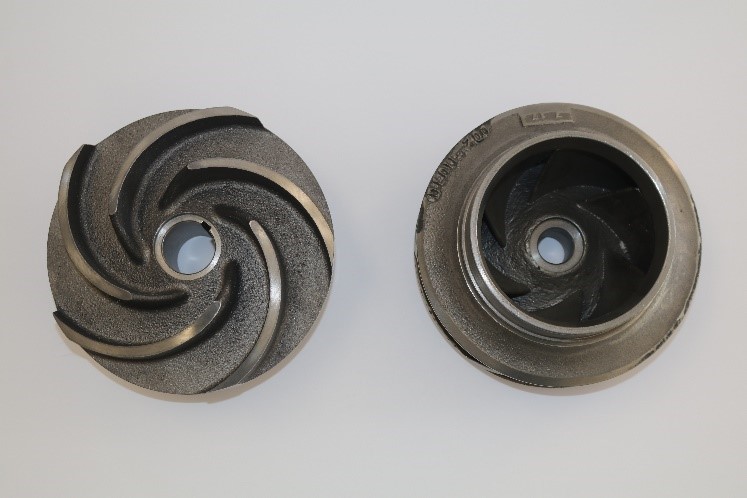Pump Impeller Selection: Semi-open vs. Enclosed
March 23rd, 2021
Enclosed and semi-open impellers are both widely used in centrifugal pump design. While enclosed impellers are typically considered more efficient, both designs have merits and are suited for different applications. In this discussion, we will be addressing single-inlet impellers, which are typically used for end-suction style pumps.

Semi-Open vs Enclosed Impellers: Flow
Enclosed impeller sandwich vanes between a front and back shroud. They are often best suited for “clean” fluids, those with low-to-moderate suspended solids. Because the flow enters through the eye of the rotating impeller and is then channeled between the shrouds in a circular/radial motion, hydraulic efficiencies are relatively high. In addition, impeller wear rings are used to restrict the amount of discharge fluid that may recirculate from high pressure (discharge) back to low pressure (suction) within the volute. This contributes to the pump’s hydraulic efficiency.
By contrast, the flow passages of semi-open impellers have a gap with the casing, which can cause irregular flow and leakage across the gap to the adjacent passage. As a result, semi-open impellers generally have lower hydraulic efficiency.
Semi-Open vs Enclosed Impellers: Cost
The use of more material (cast iron, alloys, bronze, etc.) in the casting or fabricating process of enclosed impellers generally leads to higher costs than semi-open impellers. In addition, production of the casting for an enclosed impeller at a foundry tends to be a little more complex, and therefore more expensive.
Thus, aftermarket service and repair costs can be a bit higher. When wear ring clearances become excessive, they must be replaced. Wear rings, considered to be a “wear item”, add to the costs of maintaining higher hydraulic efficiencies.
The hydraulic loads imposed on the rotor and bearings will also be different between enclosed and semi-open impellers. Since lower thrust loads equate to lower loads on the bearings and potentially lower maintenance expense, these design differences should be carefully considered.
Semi-Open vs Enclosed Impellers: Maintenance
Semi-open impellers tend to have higher axial thrust characteristics compared to enclosed impellers. This is because the forces on the front shroud of an enclosed impeller tend to counteract the forces on the back shroud.
By contrast, a semi-open impeller has no front shroud and discharge pressure can build behind the impeller. To counteract this, semi-open impellers may pump out vanes, or other mechanical means which have their own maintenance disadvantages.
After a considerable length of time in the field, the gap between the vane of a semi-open impeller and the casing will increase due to wear. This will result in a reduction of efficiency and discharge pressure.
In most semi-open pumps, the rotor itself can be adjusted to close this gap, which tends to renew the performance of the pump. In contrast, an axial adjustment of an enclosed impeller will do little to alter the performance of the pump.
Semi-Open vs Enclosed Impellers: Applications
When to use enclosed vs. semi-open impellers will depend on the application. Enclosed impellers can better compensate for shaft thermal growth due to high fluid pumping temperatures, and increased hydraulic efficiencies make it a “go-to” for clean water, high temperature, and energy-efficient applications, among others.
Semi-open impellers are better suited for solids-handling requirements since there is no impeller “eye” for through which fluid must enter, nor are there dimensional limitations an impeller with two shrouds may have. Wear on the semi-open impeller can be addressed by axial adjustments in the rotor.
There are many variables to consider beyond hydraulic efficiencies (such as electrical and total cost of operation) which should always be considered in impeller selection.
Conclusion
Knowing the differences between semi-open, and enclosed impellers will help you select the best one for your application.
Whether that’s emptying out the bilge of your ship, or pumping feed water into your boiler, the right impeller will get the job done properly and efficiently.
With the help of this article, you should now know the basics of how to select your pump impeller type.